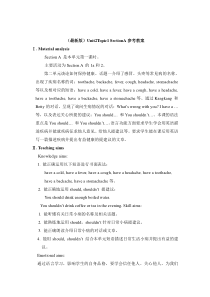 DOC
DOC
【文档说明】Unit 2 Topic 1《You should see a dentist》(SectionA)教案-八年级上册英语【仁爱版】.doc,共(8)页,47.000 KB,由小喜鸽上传
转载请保留链接:https://www.ichengzhen.cn/view-104237.html
以下为本文档部分文字说明:
(最新版)Unit2Topic1SectionA参考教案Ⅰ.MaterialanalysisSectionA是本单元第一课时。主要活动为SectionA的1a和2。第二单元谈论如何保持健康。话题一介绍
了感冒、头疼等常见病的名称,出现了疾病名称的词:toothache,backache,fever,cough,headache,stomachache等以及相对应的短语:haveacold,haveafever,haveacough,have
aheadache,haveatoothache,haveabackache,haveastomachache等。通过Kangkang和Betty的对话,呈现了询问生病情况的对话:What’swrongwithyou?Ihavea…等,以及表达关心所提的建议:Youshould…和Yousho
uldn’t…。本课的语法重点是Youshould…和Youshouldn’t…。语言功能方面要求学生学会用英语描述疾病并能就疾病征求他人意见、给他人提建议等。要求学生能在课后用英语写一篇描述疾病并提出有益健康的提建议的文章。Ⅱ.Teachingaims
Knowledgeaims:1.能正确运用以下短语进行书面表达:haveacold,haveafever,haveacough,haveaheadache,haveatoothache,haveabackache
,haveastomachache等。2.能正确地运用should,shouldn’t提建议:Youshoulddrinkenoughboiledwater.Youshouldn’tdrinkcoffeeorteaintheevening
.Skillaims:1.能听懂有关日常小病的名称及相关话题。2.能熟练地运用should,shouldn’t针对日常小病提建议。3.能正确朗读介绍日常小病的对话或文章。4.能用should,shouldn’t结合本单元短语描述日常生活小病并提出有益的建议。Emotionalaim
s:通过语言学习,影响学生的自身品格,要学会信任他人、关心他人,为我们的健康生活创建友爱、和谐的氛围。Ⅲ.ThekeypointsanddifficultpointsKeypoints:haveaco
ld,haveafever,haveacough,haveaheadache,haveatoothache,haveabackache,haveastomachache等短语的理解及运用。Difficultpoints:就日常小病用英语提建议。Ⅳ.Learnin
gstrategies1.培养学生根据图片猜单词意思的能力。2.培养学生模仿已有例句造句的能力。Ⅴ.TeachingaidsComputermultimediaprojector,picturesofdifferentillnessesEverydays
aying:Bitterpillsmayhavewholesomeeffects.良药苦口利于病。Ⅵ.TeachingproceduresStepInteractionpatternStudentacti
vityTeacheractivity1.Thewholeclasswork2.Thewholeclasswork1.Focustheirattentionontheteacher.2.Studentssingtogether.1.Greetstudentsreadyforlear
ning.2.Singasongtogether.(Clapyourhandsifyouarehappy.)TeachershowstheChinesewordsonthescreen.Introduction(7minute
s)3.Individualworkandthewholeclasswork4.Somestudents’work5.Thewholeclasswork3.Monitorgivesthereportwhiletheotherslistenandtrytoun
derstand.4.Volunteersanswer:(1)He/Shewantstobebeautiful;(2)Tobestrong;(3)Tobehealthy;5.Studentsfollowwhattheteachersays,andcome
intothenewtopicunconsciously.3.Dailyreport.TeacherasksmonitorofEnglishtogiveareportabout“TheBeijingOlympics”.4.Teacherasksaqu
estion“Whydoes…likesports?”5.Theteacherleadstothenewtopic,“Yes,ifweexerciseeveryday,wewillbemorebeautiful,strongeran
dhealthier.Ifyoudon’ttakepartinanysportsactivities,youwillbeilllikethechildrenhere.”Presentation(10minutes)1.Thewholeclasswork2.T
hewholeclasswork3.Pairwork4.Thewholeclasswork5.Thewholeclasswork6.Thewholeclasswork7.Thewholeclasswork1.Stu
dentsreadthewordsaccordingtothephoneticsymbolsandguessthemeaningsaccordingtothepictures.2.Studentstrytousetheverbphr
asestoaskandanswertogether.3.Studentsaskandanswerinpairs,using“haveacough”,“haveaheadache”,and“haveatoothache”.4.Studentslookthrough1b
andmakesuretheyknowwhattodo.5.Studentslistencarefullyandfinish1b.6.Studentssaytheanswerstogetherandunderstandthemeanin
gof“suggestion”withthehelpoftheteacher’sexplanation.7.Studentsfinish1c.1.Teacherpresentssomepicturesaboutthenewwords:fever,coug
h,headacheandstomachache.Guidestudentstolearnthewordswiththephoneticsymbols,showingtheverbphrasesunderthepictures.2.Teacherask
sandanswersabout“haveafever”asamodelforthestudentstoimitate.A:What’sthematter?B:Hehasafever.3.Teacherintroduces“What’swrongwithhim/her?”tothe
studentstodopairwork.4.Teacherleadsto1aforthestudentstofinish1b,saying“BettyandKangkangaretalkingaboutillness.L
et’slistenandfinish1b.First,youshouldlookthrough1bandmakesureyouknowwhattodo.”5.Teacherplays1a,andthenchecksthestudents’answers.6.Teacherchecksthean
swersandteachestheword“suggestion”byConsolidation(10minutes)1.Thewholeclasswork2.Thewholeclassworkandpairwork3.Groupwork4.Thewholeclasswork5.The
wholeclasswork6.Thewholeclasswork7.Thewholeclasswork8.Thewholeclasswork1.Studentsreadwiththerecording,imitatingit.2.Studentsaskandanswerinpai
rs.3.Studentsdochainpracticeingroups’makingsureeveryonecansaythedialoguecorrectly.4.Studentsdochainpracticeintheirgrou
psasquicklyastheycan.5.Studentssaytheconclusionwiththeteacher.6.Studentslookatthepicturesandknowthemeaningsofthenewwo
rds,andthenpronouncethenewwordsaccordingtothepictures.7.Studentscatchthemeaningwhiledoingexercise2.8.Studentssaytheanswerstogetherafterd
iscussion.1.Teacherplays1aforthestudentstoreadwithoutstopping.2.Teacherasksthestudentstopractice“What’swrongwithyou?Ihavea…”inpairsaccording
to1c.3.Teacherasksthestudentstoaskandansweraccordingto1cingroups.4.Teacherasksthesixgroupstodochainpractice,andthefirstthreegroupswillwi
nthegame.5.Teachermakesaconclusion,“Whenwetalkaboutillness,wemayuse—What’swrongwith…?—…have/hasa…”6.Teachershowspicturesofneww
ordsonthescreen“coffee,tea,boiledwater”withphoneticsymbols.7.Teacherexplainstheword“lift”bysayingits
synonym“carry”andasksthestudentstofinish2.8.Teacherchecksthestudents’answers.Practice(10minutes)1.Thewholeclasswork2.Groupwork
andpairwork3.Twostudents’work4.Thewholeclasswork5.Thewholeclasswork6.Twostudents’work1.Studentsmakeupnewconversationsa
ndtheymaydiscussingroups.2.Studentspreparefortheperformanceinpairs,andtworepresentativeswillbechosenou
t.3.Thepairshoulddotheirbesttoperformwell.4.Studentsknowthemeaningsandthewaystoexpresssuggestions.5.Studentslistencarefullyandfinish3.6.T
wovolunteerswritetheanswersontheblackboard.1.Teacherasksthestudentstomakeupnewconversationsaccordingto1cand2.2.Teacherasksthe
groupswhohavelostthegameofpracticing1ctopracticetheirnewconversationsinpairs.Eachgroupfinishesonepair.3.Teacherasksthebestpairtoshowtheconversationt
othewholeclass.4.Teachershows“Youshould/Youshouldn’t…”ontheblackboard.5.Teacherplays3forthestudentstofinishAin3,andthenplaysforthesecondtimeforthest
udentstofinishBin3.6.Teachercheckstheanswers.Production(8minutes)1.Thewholeclassworkandindividualwork2.Thewholeclasswork3.Thewholeclasswork4.Indivi
dualwork1.Eachstudentinterviewsonestudentandwritesdownthedialogue.2.Studentswritetheirinterviewsdownafterclass,preparingforthereportinthenextclass.3.
StudentssummarizeSectionAwiththeteacherbydoingexercisesshownonthescreen.4.Studentsdothefollowingjobs:(1)Memorizethesummaryafterclass.(2
)Studentswritetheinterview“What’swrongwithyou?”afterclass,andthenprepareforthereportinthenextclass.(3)Stude
ntslearntoreadvocabularywiththehelpofrecordingandthephoneticsymbols,andreadthedialogaftertherecording
.1.Teacherorganizesaninterviewaccordingto1cand2,andstudentswilldoitintheirowngroups.2.Teacherasksthestudentstowritedowntheirinterviewsaftercl
ass.3.Teachershowsthesummarytothestudents.(1)Vocabulary(2)thestructure:willdo4.Teacherassignshomework:(1)Reviewthesummaryafterclass.(2)Reporttheiri
nterviewstothewholeclasstomorrow.(3)PrepareSectionBafterclass.TeachingReflectionIt’salittlehardforthestudentstogiveprop
ersuggestionsonillness.Theymaysearchmoreinformationaboutthistopicafterclass.Ⅶ.BlackboarddesignUnit2KeepingHealthyTopic1Youshou
ldseeadentist.SectionAWhat’swrongwithyou?haveafever/coughIhaveabadcold.haveaheadache/stomachacheYoushouldsee
adentist.drinkenoughwaterIhopeyou’llgetwellsoon.liftheavythings
 辽公网安备 21102102000191号
辽公网安备 21102102000191号
 营业执照
营业执照